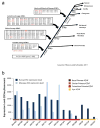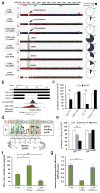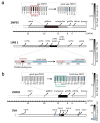An evolutionary arms race between KRAB zinc-finger genes ZNF91/93 and SVA/L1 retrotransposons
- PMID: 25274305
- PMCID: PMC4268317
- DOI: 10.1038/nature13760
An evolutionary arms race between KRAB zinc-finger genes ZNF91/93 and SVA/L1 retrotransposons
Abstract
Throughout evolution primate genomes have been modified by waves of retrotransposon insertions. For each wave, the host eventually finds a way to repress retrotransposon transcription and prevent further insertions. In mouse embryonic stem cells, transcriptional silencing of retrotransposons requires KAP1 (also known as TRIM28) and its repressive complex, which can be recruited to target sites by KRAB zinc-finger (KZNF) proteins such as murine-specific ZFP809 which binds to integrated murine leukaemia virus DNA elements and recruits KAP1 to repress them. KZNF genes are one of the fastest growing gene families in primates and this expansion is hypothesized to enable primates to respond to newly emerged retrotransposons. However, the identity of KZNF genes battling retrotransposons currently active in the human genome, such as SINE-VNTR-Alu (SVA) and long interspersed nuclear element 1 (L1), is unknown. Here we show that two primate-specific KZNF genes rapidly evolved to repress these two distinct retrotransposon families shortly after they began to spread in our ancestral genome. ZNF91 underwent a series of structural changes 8-12 million years ago that enabled it to repress SVA elements. ZNF93 evolved earlier to repress the primate L1 lineage until ∼12.5 million years ago when the L1PA3-subfamily of retrotransposons escaped ZNF93's restriction through the removal of the ZNF93-binding site. Our data support a model where KZNF gene expansion limits the activity of newly emerged retrotransposon classes, and this is followed by mutations in these retrotransposons to evade repression, a cycle of events that could explain the rapid expansion of lineage-specific KZNF genes.
Conflict of interest statement
The authors declare no competing financial interests.
Figures














Comment in
-
As time goes by: KRABs evolve to KAP endogenous retroelements.Dev Cell. 2014 Nov 10;31(3):257-258. doi: 10.1016/j.devcel.2014.10.019. Epub 2014 Nov 10. Dev Cell. 2014. PMID: 25453824 Free PMC article.
-
Transposons: catch them if you can.Nat Rev Mol Cell Biol. 2022 May;23(5):306. doi: 10.1038/s41580-022-00470-1. Epub 2022 Mar 9. Nat Rev Mol Cell Biol. 2022. PMID: 35264767 Free PMC article.
References
-
- Kazazian HH. Mobile elements: drivers of genome evolution. Science. 2004;303:1626–32. - PubMed
-
- Lander ES, et al. Initial sequencing and analysis of the human genome. Nature. 2001;409:860–921. - PubMed
-
- Wolf D, Goff SP. TRIM28 mediates primer binding site-targeted silencing of murine leukemia virus in embryonic cells. Cell. 2007;131:46–57. - PubMed
Publication types
MeSH terms
Substances
Associated data
- Actions
Grants and funding
LinkOut - more resources
Full Text Sources
Other Literature Sources
Molecular Biology Databases
Research Materials
Miscellaneous

